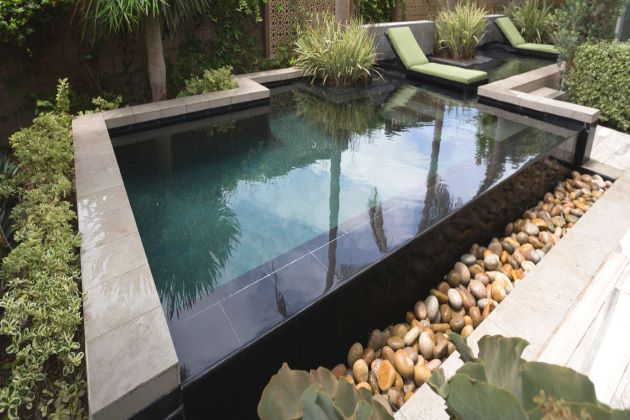How to Size a Pool Heater
Choosing the right size gas heater for your pool or spa is no quick decision, as there are quite a number of factors to consider.
Sizing a heater properly means your pool water will heat to your desired temperature in the desired timeframe. An undersized pool heater will heat too slowly, and a severely oversized pool heater may end up unnecessarily driving up the cost of this big investment. General rule of thumb with heaters: Bigger is Better, but to a certain point.
Understand Your Needs
Is this heater intended for a pool or a spa, or both? A primary factor in determining heater size is heat loss from the surface. A pool will have significantly more heat loss due to its large dimensions. With a spa this obviously is much less of a concern. Spa owners are going to be more concerned with the time it takes for the spa heater to heat up the water, relative to it’s gallonage.
Will you be using this heater for constant maintenance heating? Or for occasional “on-demand” heating? Maintenance heating will place a bit more value in your pool surface area. On-demand heating will look closely at your total pool volume. Not sure which one is you? Ask yourself if the pool is used 3+ days a week during the swimming season, if it is then you are a maintenance heater. Throw just a handful of pool parties throughout swim season? Sounds like you’re an on-demand heater.
What gas are you going to use for this heater? Do you have liquid propane or natural gas available to you? Availability of each gas varies throughout the country.
Finally, gather some details on your gas supply. You’ll need to plan for the appropriate gas line size, gas supply pressure, and the length for the distance of gas line run from the gas meter or propane tank to the heater. Having a line that’s too small, or pressure that’s too weak, will cause your heater to under-perform. If you are considering going to a larger BTU size heater from your current BTU size, you will want to know what the distance is from the gas meter or propane tank to the heater as you may need to increase the size of the gas line if it is too far away. All pool heater installation manuals will contain details on gas supply needs including the size and distance required for each BTU size.
Let’s Measure Some Things
We’ll need to collect a few key data points about your pool.
Surface Area (Best for Maintenance Heating)
- Rectangular Pool: Length x Width
- Rectangular Pool with Rounded Ends: Length x Width x 0.8
- Oval Pool: 1/2 Length x 1/2 Width x 3.14
- Kidney-Shaped Pool: Length x Width x 0.75
- Free Form Pools: No standard equation, recommend drawing your pool perimeter on grid paper and evaluating how many grid squares are 100% covered or are partial. Break it into small grids to be most accurate.
Volume (Best for On-Demand Heating)
If you anticipate on-demand heating being a common need of yours, then let’s work to calculate the Total Pool Volume.
Surface Area (as calculated above) x Average Depth of Pool x 7.48 = Pool Volume
Temperature Differential
Begin by determining your preferred water temperature; this will be unique to you. The American Red Cross recommends a range of 78-82 degrees Fahrenheit. Next, determine your average ambient air temperature. We would recommend taking the average temperature during the coldest month in which you anticipate swimming. Desired Water Temperature (80 degrees) – Average Ambient Air Temp (64 degrees) = 16 degree Temperature Differential
Heat Up Time
For spas in particular, the time to heat the water to the desired temperature is an important consideration. For on-demand heating, it can also be important to understand the amount of time needed to heat up. Most heater sizing charts assume a 24-hour Heat Up Time.
Heater Efficiency
The heater Output, or BTU, is the energy that the heater will transfer to the pool water. The heater Input is the energy, still in BTU’s, that is used to generate the output heat. Heater efficiency is the ratio of Output to Input, typically displayed as a percentage. All modern pool heaters are above an 80% efficiency rating. An efficiency rating of 84-87% is pretty typical in the pool heater industry. Heater sizing charts will typically display the needed heater Output, so there may be some math that needs to be done to calculate what the Input BTU needs to be.
Time to Do the Math
Using our generic heater sizing chart below, let’s hypothetically say we have a pool that has a Surface Area of 500 sq. ft. and our Temperature Differential needed is a 20 degree lift. We can cross reference the sizing chart and see that we require a 105,000 BTU output. Great, we are almost there!
The 105,000 BTU is the Output that we need, but heaters that you see online will be rated by it’s Input BTU. Let’s take the Hayward Universal H-Series H250FDN as an example, this heater is rated as 83% efficient.
We need to divide our 105,000/0.83 = 126,506 BTU Input needed.
The Hayward H250FDN at 250,000 BTU’s is higher than is needed, but if we oversize we’ll be able to achieve our desired temperature rise even faster.
Pool Heater Sizing Chart
| Temp. Rise | 10° | 15° | 20° | 25° | 30° |
|---|---|---|---|---|---|
| Pool Size | BTU | BTU | BTU | BTU | BTU |
| 200 sq. ft | 21,000 | 31,500 | 42,000 | 52,500 | 63,000 |
| 300 sq. ft | 31,500 | 47,300 | 73,000 | 78,800 | 94,500 |
| 400 sq. ft | 42,000 | 63,000 | 84,000 | 105,000 | 126,000 |
| 500 sq. ft | 52,500 | 78,800 | 105,000 | 131,000 | 157,000 |
| 600 sq. ft | 63,000 | 94,500 | 126,000 | 157,000 | 189,000 |
| 700 sq. ft | 73,500 | 110,000 | 147,000 | 184,000 | 220,000 |
| 800 sq. ft | 84,000 | 126,000 | 168,000 | 210,000 | 252,000 |
| 900 sq. ft | 94,000 | 142,000 | 189,000 | 236,000 | 284,000 |
| 1,000 sq. ft | 105,000 | 157,000 | 210,000 | 263,000 | 315,000 |
source: https://blog.poolsupplyworld.com/how-to-size-a-pool-heater/




